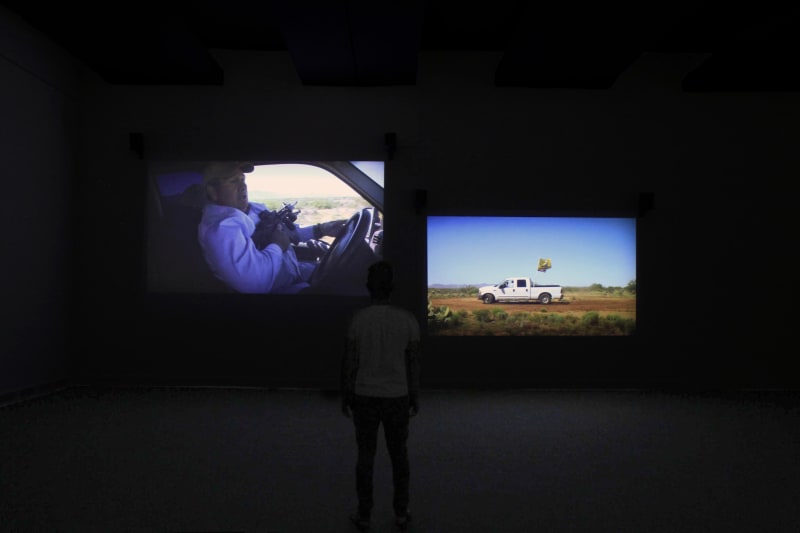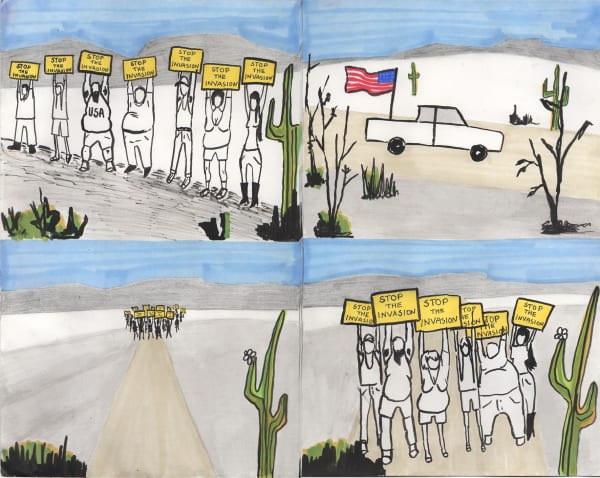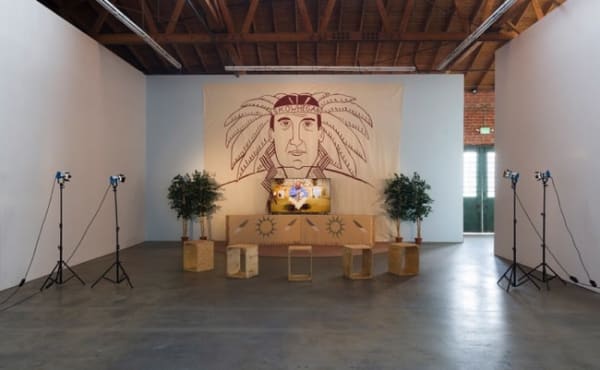Yoshua Okón
François Ghebaly is proud to present Yoshua Okón, the gallery’s first solo exhibition with the Mexican artist and cultural organizer. Across two recent video installations and a suite of storyboard drawings, the exhibition examines several of Okón’s essential strategies, drawing out reenactments and collaborations from his subjects in partially staged videos. Known for weaving together documentary and fiction, Okón’s works focus on the social performances of specific interest groups and communities in order to shed light on broader cultural and sociopolitical dynamics.
The exhibition opens with the two channel video installation Oracle (2015). Filmed in Oracle, Arizona, the film centers on the leaders of a major protest against the entrance of unaccompanied children from Central America into the United States, organized by a militia called the Arizona Border Defenders. The organizers agreed to stage scenes based on their extreme nationalist ideology as well as to create a live reenactment of the protest for Okón’s camera. The title Oracle also refers the Oracle Corporation, a company known to have ties to the CIA and a perfect example of the current geopolitical paradigm in which state structures are increasingly at the service of private interests. Oracle questions the adequacy and the relevance of nationalism in an age of transnational interconnection.
The exhibition continues with The Indian Project: Rebuilding History (2015), an installation and video that examines the town of Skowhegan, Maine. Once named Milburn, the town changed its name in the 19th century to what was considered its former Abenaki, Native American name. New England, where Skowhegan is located, was the site of some of the worst Native American genocides on the continent and the town has no remaining Native American population or cultural influence. During the 1960s, the town’s Chamber of Commerce decided to erect an 80 feet tall wooden sculpture of a Native American man, which they refer to as “the tallest Indian in the world.” In the summer of 2014, the Chamber of Commerce conducted a restoration of the sculpture. Okón invited the members of the committee tasked with the restoration to conduct a program and performance at their local TV station. The committee members were asked to talk about the history of the statue and about the town’s adoption of a Native American identity. The discussion gives way to a “Native American Trance Ceremony” based on the committee’s own notions of what that constitutes.
With this pairing of works, Okón builds a portrait of a particularly American relationship to history, one full of gaps and myth. An artist deeply engaged with notions of transnationalism and the localized effects of global forces, Okón deploys playfulness and critique in equal measure, creating an unwieldy mirror for seeing the ways unpleasant histories can be lodged invisibly in contemporary daily life.
Yoshua Okón (b. 1970, Mexico City) was a cofounder and director of the landmark artist-run space La Panadería Gallery (1994-2003), and is the founder of the non-profit artist-run space SOMA, which has operated a postgraduate art program and residency in Mexico City since 2009. Okón is recognized as a pivotal figure in the contemporary art of the Americas, and his work is held in numerous public collections including the Tate Modern, London; Hammer Museum, Los Angeles; Colección Jumex, Mexico City; and LACMA, Los Angeles. He has recently shown in solo exhibitions at Colby Museum, Maine; Amparo Museum, Puebla; Museo Universitario de Arte Contemporáneo (MUAC), Mexico City; Artspace, Sydney; Asakusa, Tokyo; Utah Museum of Contemporary Art, Salt Lake City; and Hayward Gallery, London. Okón lives and works in Mexico City.
Oracle is produced in conjunction with the Arizona State University Art Museum, curated by Julio Cesar Morales.









